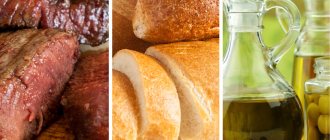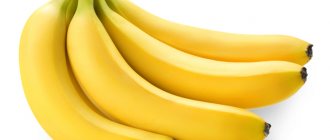If the weight is a couple of tens higher than required. What to do? Consider the ratio of proteins, fats and carbohydrates for weight loss and run a lot, a lot. And once draw up a diagram for yourself - the optimal percentage of BZHU for every day. This is a guaranteed success.
Hello again, guys! Svetlana Morozova is with you, I’ve been daydreaming about magical means for losing weight)). But dreams are dreams, but you still have to prepare for summer in more realistic ways. And first of all, build your diet wisely. This is what I will talk about today.
Friends, read the article further, there will be a lot of interesting things in it! And for those who want: “Find out the degree of slagging in your body” or “Find out what’s stopping you from losing weight?” Take Selection TEST
Why does the body need carbohydrates?
Carbohydrates are organic substances consisting of hydrogen, carbon and oxygen.
A person is able to generate a source of energy on his own, but the main supply of strength comes from eating food. Cereals contain 85% carbohydrates, sugar – 99%.
The first type is found in sugar, honey, and sweets. Such substances are easily absorbed by the body and enter the bloodstream. Doctors recommend consuming these products in small quantities.
Complex carbohydrates include starch, fiber, dietary fiber, etc. They are absorbed more slowly. They are allowed to be consumed in sufficiently large quantities.
Functions of carbohydrates in the human body:
- provide energy;
- strengthen tissues;
- prevent the growth of bacteria in the stomach;
- break down fats;
- normalize the functioning of the immune system;
- participate in the formation of enzymes and the production of hormones.
The process of losing weight should not be accompanied by deterioration in health, so restrictions in the amount of food and its calorie content must be compensated by proper quality. The importance of the presence of proteins, fats and carbohydrates in the diet is due to their effect on the body.
- Proteins are an essential element for gaining muscle mass, and their deficiency makes it difficult to break down fat tissue.
- An excess of fats, especially of animal origin, is the main cause of excess weight, but their lack is no less harmful, because fats are involved in the production of hormones, the absorption of fat-soluble vitamins and the functioning of the immune system. In addition, fats affect the condition of the skin, which is why it is so important for women to adhere to the minimum acceptable values for the consumption of this element.
- Reducing your carbohydrate intake is the fastest way to losing weight, but it is fraught with health problems. Eating carbohydrates found in vegetables and grains helps fight fat accumulation, while carbohydrates derived from sugar or flour, on the contrary, lead to excess weight.
The relationship between carbohydrates and weight loss
Carbohydrates are the carrier of calories or the primary source of energy for our body.
Some of their types begin to be absorbed already in the mouth, quickly enter the circulatory system and are delivered to the cells of the muscles, brain and other organs and tissues for their nutrition.
Insulin plays an important role in the delivery of nutrients to cells - a transport hormone that is responsible for the delivery of nutrients into the cells.
— Why is it so easy to gain fat mass on carbohydrates?
The body's natural response to carbohydrates is to increase insulin levels, the purpose of which is to lower blood sugar levels.
Sugar here refers to glucose - a basic simple carbohydrate, to the level of which almost all carbohydrates break down during digestion.
When carbohydrates are eaten in quantities exceeding the body's need for energy, the excess of them, with the help of insulin, is sent for storage first to short-term energy stores - muscle and liver glycogen, and after they are filled - to long-term stores: body fat, which, as is known, can be almost dimensionless.
It turns out that the more carbohydrates in the diet, the higher the insulin level and the more favorable the conditions for fat deposition .
And vice versa: the fewer carbohydrates, the better the conditions for fat burning.
This is only one side of the coin.
Excess refined sugar in the diet leads to hormonal changes that further interfere with weight loss: in particular, the formation of immunity to leptin, a hormone that controls appetite.
This manifests itself in the fact that a person eats, but does not feel full, which means he regularly overeats. Excess calories, in turn, is the main cause of the obesity epidemic in our society, and not a lack of physical activity, as we are sometimes led to believe.
The human body has a hormonal mechanism that converts excess carbohydrates into fat; in addition, when there are a lot of simple carbohydrates in the diet, the hormonal mechanism for regulating appetite may be disrupted, which provokes overeating
We recommend : Milk: benefits and harms for the human body. Scientific facts
Optimal ratio of proteins, fats and carbohydrates
Increasing physical activity is important when losing weight, but proper nutrition should come first.
Important! If physical activity can provoke a diet breakdown, then it is better to exclude it.
It’s better to increase your everyday activity: buy a fitness bracelet or install a pedometer on your phone and measure how many steps you take per day. You can put an expander, a rubber band for fitness, a hula hoop, dumbbells next to the sofa and start doing 1-3 exercises while watching your favorite movie. Clean the house every day, stop using the elevator, etc.
The BJU norm is determined individually for each person, based on weight, age, gender, and activity. However, nutritionists are of the opinion that the optimal proportion is 1:1:4. This ensures a balanced diet and the required amount of calories. For athletes and muscle growth, the distribution formula is different - 1: 0.8: 4, and for gaining large mass, the need for carbohydrates will increase by 2 times.
Do you want to become slimmer? Then the calculation of BZHU for weight loss as a percentage will have a different form. You can start the fat burning process by increasing the percentage of proteins (white meat, eggs, seafood, cottage cheese, milk and kefir) and reducing carbohydrates (sweets, baked goods, pasta, potatoes). You shouldn’t go to extremes, test yourself at a minimum - keep the ratio of proteins, fats and carbohydrates “adequate” for weight loss. The main thing is to know the optimal combination. Plus, don’t disdain training: muscle tone is good. Don't forget about healthy sleep.
Let’s take a person’s daily diet as a conditional 100%. You will begin to lose weight if you follow a diet that consists of 30-35% proteins, 10-25% fats, 45-50% proper carbohydrates. If you are going to undergo drying, then you need to reduce carbohydrates and fats to a minimum. The ideal percentage ratio of BJU for weight loss is 30:20:50%.
Ideal percentage for weight loss
It is important to correctly calculate KBJU for weight loss for women and men. Until today, the ideal proportion was considered to be 1:1:4. But this proportion is incorrect. It causes a lack of proteins and an excess of carbohydrates.
There is a certain percentage of BZHU in the table
| BJU | For women | For men |
| Squirrels | 0.4 | 0.5 |
| Fats | 0.3 | 0.4 |
| Carbohydrates | 0.3 | 0.5 |
If we consider the ratio of BZHU for weight loss as a percentage for women, then the following formula comes out - 40:30:30%, and for men - 50:40:50%.
But you won’t be able to calculate all the correct ratios of BJU when losing weight on your own; for this you will definitely need the help of an experienced nutritionist or nutritionist. He will be able to determine which products must be on the menu, and he will also set their quantity. But at the same time, there should not be a deficiency or excess of one of the components; everything should be within normal limits.
To correctly calculate your nutritional intake for weight loss, you should pay attention to the products that you constantly consume. If you want to give up pasta, then don't. It is enough to replace them with spaghetti made from durum wheat; you can also reduce the volume of one serving. You should not use ketchup, mayonnaise, or certain sauces; they will increase your appetite and increase weight gain.
To ensure that your body receives the required amount of proteins, carbohydrates and fats every day, eat more plant foods, and you do not need to give up foods that contain polyunsaturated fatty acids. When losing weight, the body definitely needs building material, energy supply for the body.
There is no need to arrange fasting days or go hungry. As a result, you will only lose water, but your weight will remain the same, and in the future it may increase several times. Nutritionists recommend eating everything, but in small quantities. When losing weight, you can even eat dark chocolate, but only before 16:00.
Instead of store-bought baked goods, eat only homemade ones; they should contain stevia instead of sugar. Store-bought juices can be replaced with fresh juices and fruit infusions. Carbohydrates are found in dark cereals, bran and black bread, various vegetables, and unsweetened fruits.
In the morning you can have cottage cheese with dried fruits or porridge for breakfast, boiled breast with stewed vegetables for lunch, stewed fish and a salad of fresh tomatoes and bell peppers for dinner. Don’t forget about snacks, meals should be divided, up to 5-6 meals a day.
Create a menu for weight loss using the following video:
Pay attention to foods from which you can get a certain amount of nutrients:
- Approximately 45% of the protein can be obtained from lean meats and products of plant origin;
- About 70% of fats should be natural - they can be obtained from milk, chicken eggs;
- The required percentage of proteins (55) is found in foods of plant origin (legumes, nuts);
- 30% of fats are found in avocados, vegetable oils, and various seeds.
What to do to ensure that calorie counting fits harmoniously into your lifestyle
The process of losing weight occurs when energy sources do not enter the body. It needs nutrients, which it takes from fat deposits.
Nutritionists strongly recommend avoiding the following foods:
- flour products and potatoes;
- chips, crackers, instant noodles, cereals;
- sweets;
- carbonated drinks, tea with sugar, coffee;
- fruits and berries rich in fructose: bananas, nectarines, plums.
Rules for low-carb diets
Despite the fact that carbohydrates are extremely necessary for the body, including those who are overweight, many resort to low-carb diets to get rid of extra pounds. Even a healthy diet assumes that a person will eat whole grain bread, cereals, fruits, and vegetables. But for extreme weight loss, some still decide to completely exclude them from their menu.
We must understand that such a solution should be short-term. Under no circumstances should you give up such products forever, as this will cause serious and irreversible damage to the body.
If you nevertheless decide on such a diet, you should remember a number of rules for such diets. So, they exclude from the diet any kind of sweets, sugar, flour products, even pasta and bread. You will also have to give up rice, potatoes and other starchy foods.
Despite the fact that the diet is considered carbohydrate-free, you can consume them, but not more than 40 g per day. They should be consumed with herbs, vegetables, and low-fat dairy products. In addition, you need to eat lean fish, meat, and seafood.
You should also drink about 2.5 liters of water per day to improve your metabolism. Physical exercise will be beneficial as it will force the body to burn stored fats.
How to calculate daily calorie intake?
((Weight in kg x 9.99) (height in cm x 6.25) - (age in years x 5) - 161) x physical coefficient. activity.
This coefficient is determined as follows:
- with a sedentary lifestyle it is 1.2;
- insignificant physical activity, manifested in rare walks and irregular exercise, gives a coefficient of 1.4;
- if you visit the gym periodically (at least 2-3 times a week), the coefficient will be 1.6;
- daily intensive sports activities will allow you to count on the maximum coefficient value - 1.7.
We suggest you read Buckwheat with kefir in the morning on an empty stomach: benefits and harms
((80x9.99) (165x6.25) - (30x5) - 161) x 1.4 = 2130 kcal.
However, to lose weight, the resulting figure must be reduced by 20%, so the caloric content of food in this example should not exceed 1700 kcal.
There is another formula, the Harris-Benedict formula, according to which it is necessary to calculate the values of basal and active metabolism, and then multiply the resulting numbers.
(Weight in kg x 9.247) (height in cm x 3.098) - (age in years x 4.33) 447.593.
The value of active metabolism is:
- with a sedentary lifestyle 1.2;
- at low and irregular loads 1.375;
- with mediocre physical activity 1.55;
- with intense activity 1.725;
- for athletes 1.9;
- for muscle building 1.2;
- for weight loss 0.8.
((80 x 9.247) (165 x 3.098) - (30 x 4.33) 447.593) x 0.8 = 1250 kcal - this is exactly how many kilocalories this woman should receive in order to get rid of extra pounds.
To find out your daily intake of proteins, fats and carbohydrates, you must first calculate your calorie content. This can be done using a calculator using the formula for calculating basal metabolic rate (BMR).
Calculation of ALE
| Ka | Description |
| 1,2 | No physical labor or minimal activity |
| 1,38 | Standard classes 3 days a week |
| 1,46 | Standard classes 5 days a week |
| 1,55 | Hard training 5 days a week |
| 1,64 | Daily workouts |
| 1,73 | Heavy daily training or training twice a day |
| 1,9 | Daily training and physically demanding work |
Now you can easily calculate your daily calorie intake (CD). To do this, you need to multiply the OOV value by the activity coefficient.
Sn = OOB x Ka
The resulting amount of calories is necessary to maintain weight.
For example, you can take a 25-year-old girl, 165 cm tall, weighing 50 kg, training 3 times a week. The basic metabolism for her will be equal to: 50 x 10 (165 x 6.25) - (25 x 5) - 161 = 1245.25 kcal. Now this number needs to be multiplied by the activity coefficient of 1.38. The result will be 1718 kcal.
After calculating the calorie content, you need to determine the optimal ratio of proteins, fats and carbohydrates. This is required to improve the quality of the body, since without enough protein, the muscles will not receive sufficient nutrition and the skin will lose its elasticity. Carbohydrates are necessary to provide the body with energy, but their amount should not exceed the norm, otherwise excess fat deposits will form.
The correct ratio of BZHU to achieve a particular goal is shown in the figure.
When creating a menu, you should adhere to exactly this ratio.
There is a way to easily determine specific norms for protein, fat, and carbohydrate consumption per day. To do this, you need to know how many calories are in these macronutrients:
- 1 g protein - 4 kcal;
- 1 g fat - 9 kcal;
- 1 g of carbohydrates - 4 kcal.
Now you will need to calculate the shares of BZHU in the total daily calorie content. It’s worth returning to the example: a girl needs to consume 1718 kcal. The ratio of macronutrients for weight maintenance will be:
- proteins - 30%;
- fats - 25%;
- carbohydrates - 45%.
To calculate the protein norm, you will need to multiply 1718 kcal by 0.3 = 515.4 kcal. This value must be divided by 4 kcal, since this is the energy value of a gram of protein. The result will be 128 g. This is how many grams of protein the girl in the example needs to consume to maintain weight. You can also calculate the amount of fat (1718 x 0.25 = 429.5 kcal or 47 g) and carbohydrates (1718 x 0.45 = 773.1 kcal or 193 g).
So, the girl from the example needs to consume 128 g of protein, 47 g of fat and 193 g of carbohydrates per day to maintain her weight.
First, it is important to determine the calorie content that the body needs for a day, and then you can calculate the BZHU for weight loss. So, several steps:
- Calculation of metabolic rate: 655 (9.6 * current weight in kilograms) (1.8 * your height) – (4.7 * full years).
- Let's adjust for your activity: very low (constantly sit) - 1.20, low (exercise a couple of times a week) - 1.38, medium (up to 5 times every week, exercise with a light load) - 1.55, high (do intense and complex training) – 1.73.
- From the obtained result we subtract 500 calories, we get the daily norm, for example, 1500.
- You can expand the limit: -200 calories (1300-1700). Below this is already harm to the body, slow metabolism, hormonal imbalance. Above - forget about the fact that you will lose weight, on the contrary, you will gain excess weight, because the proceeds will not be spent.
Based on the information received and knowledge about the level of substances, we can summarize that the protein norm for weight loss is 1300 (calories) * 0.30 (normal protein level) / 4 (kcal per 1 g), i.e. 97.5 g .This is the lower limit. The upper limit will be 1700 * 0.35 / 4 = 149 g. Your permissible intake is 97-149 g. Remember, falling below the limit means exposing the body to increased stress. Instead of fat burning, you will get stagnant metabolism.
In the same way, we calculate the amount of fat when losing weight. Minimum formula: 1300 (calories) * 0.15 (normal fat level) / 9 (kcal per 1 g), i.e. 22 g. Upper limit: 1700 * 0.20 / 9 = 38 g. If you increase the grams , then you will not achieve the weight loss effect. Stick to the recommended values (in our case, from 22 to 38 g) and you will definitely see the result.
The third group of our ratio is calculated in exactly the same way. The minimum amount of carbohydrates per day when losing weight will be 146 g: 1300 (calories) * 0.45 (normal level) / 4 (kcal per 1 g). At the same time, the upper threshold for active weight loss is 191 g: 1700 * 0.50 / 4. Keep in mind that you need to give up fast calories - chocolate, cookies, chips, crackers, bananas, potatoes are also prohibited. They are no help to us in the battle with excess hated weight! You need slow "comrades".
We suggest you familiarize yourself with Exercises for the hands - so that the skin on the inside of the hand does not hang
Information needed before starting the diet
Thinking about proper nutrition for the first time and reading descriptions of various diets, beginners almost immediately wonder how many carbohydrates they need per day when losing weight. However, experts will say that there is no clear answer to this question.
First of all, you need to consult a professional nutritionist who will help identify the cause of excess weight. After all, the list of factors influencing body weight gain is quite wide. Sometimes, weight problems can be associated with hormonal imbalance and a number of other malfunctions of the human body. In this case, in addition to working on your diet, you need to undergo the necessary treatment from doctors.
Healthy food
Important! If the root of the problem lies in poor nutrition, then it is worth observing your eating habits for several days and keeping notes, putting in a notebook absolutely all the dishes and products that a person eats per day, including snacks.
List of details to consider before starting the diet:
- You shouldn’t focus only on diet; you need to enter the process of losing weight smoothly and as painlessly as possible for a person’s consciousness, because it’s not so easy to get rid of bad habits.
- A proper diet does not involve fasting or extremely low intake of proteins and other beneficial nutrients.
- Lack of sleep also leads to gaining extra pounds, so it’s worth establishing a proper sleep schedule and allowing your body to get enough sleep.
- With age, the amount of muscle decreases and is replaced by more fat, so you need to accustom yourself to strength training and protein nutrition.
- It is necessary to take into account the daily intake of carbohydrate foods.
The muscles of the body must be kept in good shape; it is impossible to manage with food restrictions alone. If a person wants to lose weight without harming his own health, he needs to develop a training plan and regularly visit the gym.
How many carbohydrates do you need per day when losing weight?
In order to find out the daily norm of energy sources, it is necessary to calculate how many calories a particular person should consume. Based on this figure, you can calculate how much carbohydrates he needs to receive.
Number of calories per gram of each macronutrient:
- Proteins – 30% of calories. 1 gram = 4 kcal.
- Fats – 30% of calories. 1 gram = 9 kcal.
- Carbohydrates – 40% of calories. 1 gram = 4 kcal.
If a person’s norm is 1500 kcal, then the table of proteins, fats and carbohydrates will look like this:
- proteins: (0.3*1500/4) = 113 g;
- fats: (0.3*1500/9) = 50 g;
- carbohydrates: (0.4*1500/4) = 150 g;
It is difficult to adhere to exact numbers, so an error of 5% of the established norm is allowed.
The required amount of energy sources depends on a person’s gender, weight and age.
Be sure to read:
Diet “90 days”: separate meals for weight loss, detailed menu and recipes
| Category | Weight | |||
| 40-50 kg | 50-60 kg | 60-70 kg | 70-80 kg | |
| Man gaining weight | 283 g | 294 g | 305 g | 322 g |
| Man losing weight | 159 g | 163 g | 168 g | 173 g |
| Man maintaining body weight | 210 g | 287 g | 303 g | 323 g |
| Woman gaining weight | 203 g | 242 g | 258 g | 271 g |
| Woman losing weight | 118 g | 150 g | 165 g | 153 g |
| Woman maintaining body weight | 145 g | 187 g | 205 g | 217 g |
The energy released is measured in kilojoules and is called calories. It is necessary to consume the daily norm of energy value.
Otherwise, the person loses or gains weight.
- Proteins: 1 gram = 16.7 kJ.
- Fat: 1 gram = 37.7 kJ.
- Carbohydrates: 1 gram = 16.7 kJ.
Based on these data, you can calculate the energy value of any product. Using wheat bread (second grade) as an example, let’s find the number of calories in 100 g.
It contains 7.1 g of protein, 1.1 g of fat and 46.4 g of carbohydrates. The energy value will be equal to: 16.7*7.1 37.7*1.1 46.4*16.7=934 kJ (234 kcal). The calorie content is written on packages of goods, but with fruits, vegetables and flour products you will have to calculate it yourself.
Daily calorie content is determined by the sum of the energy value of food eaten per day.
Depending on how long a person wants to lose excess weight, nutritionists draw up the daily intake of foods containing carbohydrates:
- 100-150 g. Average value, which is suitable for maintaining mass. Further reduction in the norm will lead to weight loss.
- 50-100 g. By taking this amount of carbohydrates, a person will begin to lose kilos without feeling it. It is only important to maintain a diet and eat food that does not leave you feeling hungry for a long time.
- 20-50 g. This amount will lead to weight loss in a short time.
The type of life a person leads plays a big role. During physical activity, nutritionists believe that it is necessary to consume 4 g of carbohydrates per kilogram of a person’s weight.
It is important to exercise, otherwise the weight will not come off. In the absence of physical activity, the norm drops by half - to 2 g per kilogram of body weight.
What is BJU?
Many people often wonder what BZHU is? Literally, this formula stands for proteins, fats and carbohydrates. These components are included in almost any product. After entering the body, each of them performs certain functions, affects the well-being and functioning of internal organs, as well as body weight and human health.
It is worth noting! An abbreviation with the addition of the letter “K” in front is often found - KBZHU. It stands for calories, proteins, fats and carbohydrates.
Each product has a certain calorie content, which provides a person with the required energy. He receives the required portion of calories while eating food. The smaller it is, the more intensely the body has to burn fat deposits. In order to lose weight, one indicator is important - the percentage of BJU in each product. If it is close to normal, this means that the diet is correct and does not have a negative impact on health.
There are certain formulas that can be used to calculate the optimal combination of proteins, fats and carbohydrates, as well as the normal calorie content. Moreover, all this is determined for each person individually. According to the BZHU, a menu will be drawn up in the future, which will contain all substances within normal limits.
Norm of BZHU for women and men, depending on lifestyle
The rate of consumption of BJU for women and men may depend on the type of activity and lifestyle. If, for example, a person is constantly busy with mental work, but practically does not work physically, then his norm will be different from workers in the field of heavy physical activity.
There are several categories of activity, depending on which the BJU norm is calculated:
- Group I. It includes knowledge workers;
- Group II. This includes work involving light physical labor;
- III group. Medium hard work;
- Activities involving heavy physical work.
Below is a table with complete BJU data for men and women, depending on category and weight.
| Group | Weight, kg) | Women | Men | ||||||
| Calorie content (kcal) | Proteins (g) | Fat (g) | Carbohydrates (g) | Calorie content (kcal) | Proteins (g) | Fat (g) | Carbohydrates (g) | ||
| I | 50 | 1400-1500 | 95 | 50 | 150 | 1700 | 107 | 68 | 172 |
| 60 | 1500-1650 | 125 | 55 | 165 | 1850 | 117 | 73 | 181 | |
| 80 | 1700-1880 | 140 | 65 | 185 | 2100 | 129 | 82 | 207 | |
| 100 | 1900-2150 | 160 | 70 | 210 | 2300 | 143 | 87 | 232 | |
| II | 50 | 1730 | 110 | 68 | 175 | 1960 | 124 | 79 | 197 |
| 60 | 1900 | 119 | 74 | 188 | 2100 | 133 | 83 | 210 | |
| 80 | 2150 | 135 | 85 | 215 | 2400 | 149 | 93 | 236 | |
| 100 | 2450 | 153 | 95 | 243 | 2650 | 167 | 105 | 262 | |
| III | 50 | 1880 | 120 | 75 | 190 | 2130 | 134 | 82 | 214 |
| 60 | 2050 | 129 | 80 | 205 | 2300 | 143 | 86 | 229 | |
| 80 | 2400 | 145 | 90 | 235 | 2600 | 162 | 100 | 260 | |
| 100 | 2800 | 165 | 104 | 265 | 2730 | 180 | 113 | 289 | |
| IV | 50 | 2150 | 135 | 85 | 216 | 2410 | 153 | 92 | 243 |
| 60 | 2300 | 146 | 90 | 232 | 2600 | 162 | 100 | 257 | |
| 80 | 2700 | 165 | 104 | 266 | 2920 | 187 | 115 | 291 | |
| 100 | 3000 | 187 | 118 | 297 | 3300 | 205 | 129 | 325 |
BZHU calculation formula
The ratio of proteins, fats and carbohydrates for weight loss can be different - we figured that out. Calculating BJU for weight loss is simple, it won’t take much time. The nutrition program is compiled individually, so the calorie counter and percentage of organic compounds may vary. A rational combination of diet, exercise and rest will help you lose weight. Determine the best option yourself or online using a calculator!
You don’t have to bother with calculations, but use the BZHU calculator online. All you need is to write down your weight, height, gender, goals (lose/gain weight), and lifestyle. The system will calculate the rest automatically. No decryption needed. The calculator will help answer the following questions:
- How many calories do you need per day?
- How many kcal do you need to consume to gain/lose/stay in shape?
- Do you have enough BJU? Your norm of BZHU per day is the boundary limits.
Summary
If you don’t know how to correctly calculate the ratio of proteins, fats and carbohydrates when losing weight, then be sure to remember a few important recommendations. They will help you quickly lose extra pounds and get in shape:
- Give up diets, it is better to use formulas for calculating BZHU;
- In the morning you can eat sweets, baked goods are allowed. During the day you can quickly burn the accumulated calories;
- Breakfast should consist of slow carbohydrates - cereals, egg dishes, whole grain bread;
- Instead of sugar, you should use natural honey or sweeteners;
- Lunch should be complete, it should consist of two courses;
- Don't forget about snacks, but only if you feel hungry;
- It is recommended to eat up to 5-6 times a day, but in small portions;
- For dinner you should eat something light - vegetable salad, baked fish, boiled chicken;
- When purchasing products, carefully study the calorie content, BJU;
- Skip frying;
- Write down the number of calories you consume every day; do not exceed the norm.
Losing weight with the help of BZHU is an effective method that allows you to quickly get your figure in order. The main thing is to study its main features, calculation rules and percentages. If you follow all the rules, you can get excellent results in a few weeks. And most importantly, without hunger strikes and giving up your favorite foods.
Rules for consuming healthy carbohydrates for weight loss
The quality of the calories you consume is one of the components of successful weight loss. You need to get the nutrients you need to stay healthy from the right foods. Which ones?
Proteins for weight loss
It is wrong to think that this is exclusively meat, fish, poultry, eggs, and dairy products. Proteins can be of both animal and plant origin, and plant protein can be no less complete than animal protein.
We invite you to familiarize yourself with the body, the ideal option for those women who want to quickly lose weight
So, vegetarians and all supporters of a healthy diet can take them in whole grains:
- cereals (priority barley, buckwheat, wheat, etc.)
- soy and soy products (e.g. tempeh, soy milk, tofu)
- legumes (chickpeas, beans, lentils)
- fruits, berries, greens, asparagus, broccoli
- chia seeds.
If you train, calculate the amount of protein 1.5-2 g per kilogram of weight. At the same time, this norm is suitable for women, but for men it should be increased to 3g.
Fats for benefit
Fats are not harmful at all, but very beneficial. They are needed for a number of important matters. This is energy for life, transportation of nutrients and absorption of vitamins.
And many more necessary processes for life. The main thing is to know which ones to choose. I wrote about good fats in the article “What are the benefits of fats.”
The best ones are the unsaturated ones, those that contain Omega-3 and Omega-6 fatty acids. You need to look for them in
- flaxseed, soybean, hemp, olive, sesame, corn oils
- unroasted nuts (sesame, hazelnuts, chia, almonds, pumpkin, cashews, walnuts, sunflower seeds)
- beans
- leafy greens
In addition, sea fish such as herring, salmon, and mackerel are rich in healthy fats.
Normal – 1 g of fat per 1 kg of weight
A spoonful of oil in a salad and a handful of seeds in porridge are a great way to provide the body with the right amount of healthy, rather than harmful, cholesterol.
Healthy carbohydrates are complex organic substances; they are the ones that need to be included in your diet when losing weight.
You need to know a number of rules, without which the desired result cannot be achieved:
- Simple carbohydrates should make up only 15% of the components consumed. The remaining 85% is starchy.
- It is necessary to eat vegetables and fruits rich in fiber.
- To lose weight, it is important to consume proteins together with carbohydrates, as they will help gain lean body mass.
- You should not eat a lot of food at one time. It is better to break your meals into several parts and eat in small portions.
- Confectionery products are best consumed in the morning, before lunch. In the evening, sucrose is poorly absorbed by the body, which causes unnecessary fat mass to appear.
When creating any diet, it is necessary to include a combined set of products. You can’t eat just one thing, like rice. When dieting, it is necessary to include vegetables and grains in the diet.
Daily norm
Now let's determine what the daily intake of carbohydrates should be for weight loss. One gram of carbohydrates provides 4.1 kcal. But the rate of their consumption is an individual indicator, which depends on gender, age, physical activity, and the state of human health. A specialist will accurately calculate the norm. You can also turn to special calculators, where after entering the necessary data, the system will give you the optimal indicator.
But as a general rule, the amount of carbohydrates in a person’s diet should be approximately 50%. Of these, simple ones can be consumed no more than 36%, and preferably less. The rest is complex carbohydrates. It is also necessary to give preference to foods with a low glycemic index.
In addition, it is important to take carbohydrates at the right time:
- Immediately after class. It is recommended to use the carbohydrate window after exercise for weight loss. The fact is that after intense exercise, the muscles are depleted of glucose reserves, and they strive to quickly replenish them. It is at this time that you can eat foods with a high glycemic index, and they will not affect your body fat percentage.
- Two hours after training, and every two hours throughout the day. It is especially beneficial to eat starchy carbohydrates within three hours after exercise.
Consequences of a lack of carbohydrates
With a lack of carbohydrates, the body begins to signal a malnutrition. First of all, the body begins to take energy from proteins. Because of this, they cannot perform their functions: synthesize new cells and tissues, produce antibodies and hormones.
Many diets are based on eliminating foods rich in carbohydrates. However, their absence in the body can disrupt the process of burning fat deposits, and the person, on the contrary, will gain weight.
Due to the lack of these components, a person experiences nausea, accompanied by vomiting, headaches, lethargy and fatigue.
What is considered a low carb diet?
There is no clear definition of what exactly a low-carb diet is.
A person's optimal carbohydrate intake depends on their age, gender, body composition, level of physical activity, personal preference, dietary culture, and current metabolic health.
People who are physically active and have more muscle mass can tolerate much more carbohydrates than people who are sedentary. This is especially true for those who do a lot of high-intensity exercise, such as weight lifting or sprinting.
Metabolic health is also a very important factor. When people develop metabolic syndrome, obesity, or type 2 diabetes, their carbohydrate needs change.
People who fall into these categories are less able to tolerate many carbohydrates.
Conclusion:
Optimal carbohydrate intake varies between individuals, depending on physical activity level, current metabolic health, and many other factors.
How to calculate daily calorie intake?
To maintain or lose weight, it is important to know how many calories you need to consume daily.
You can use the following simple algorithm:
- Multiply the mass of a person by 10.
- Human height multiplied by 6.25.
- Add the results of steps 1 and 2.
- Number of years multiplied by 4.9.
- Subtract the result of the calculations in step 4 from the number obtained in the calculation of step 3.
- For men, add the number 5 to the result of step 5, for women, subtract 160.
- The resulting number in step 6 is multiplied by the physical load coefficient:
- In the absence of physical activity, it is equal to 1.2.
- If a person walks a lot, sometimes goes to the pool or does exercises at home, then the coefficient is 1.4.
- If you exercise several times a week – 1.6.
- If a person trains daily and is highly active, then the result obtained in step 6 is multiplied by 1.7.
Table of the amount of carbohydrates in food
List of foods indicating the amount of carbohydrates (simple or complex) and calories in them:
| Product | Carbohydrates (g/100 g) | Calorie content (kcal/100 g) |
| Vegetables, fruits, berries | ||
| Eggplant | 5,5 | 24 |
| Green pea | 13,3 | 72 |
| Zucchini | 5,7 | 27 |
| White cabbage | 5,4 | 28 |
| Boiled corn | 22,5 | 70 |
| Potato | 19,7 | 83 |
| Bulb onions | 9,5 | 4,3 |
| Celery | 4,1 | 25,7 |
| Carrot | 7 | 33 |
| cucumbers | 3 | 15 |
| Sweet pepper | 5,7 | 27 |
| Salad | 2,2 | 14 |
| Beet | 10,8 | 48 |
| Tomatoes | 4,2 | 19 |
| Orange | 8,4 | 38 |
| Banana | 22,4 | 91 |
| Cherry | 11,3 | 49 |
| Watermelon | 8,8 | 38 |
| Grapefruit | 7,3 | 35 |
| Pear | 10,7 | 42 |
| Kiwi | 8 | 47 |
| Lemon | 3,6 | 31 |
| Apple | 11,5 | 48 |
| Grape | 17,5 | 69 |
| Strawberries | 8 | 41 |
| Cranberry | 4,8 | 28 |
| Raspberries | 9 | 41 |
| Red currants | 8 | 38 |
| Dates | 69,2 | 292 |
| Blueberry | 8,6 | 40 |
| Cereals | ||
| Buckwheat | 68 | 329 |
| Manna | 73,3 | 326 |
| Oatmeal | 65,4 | 345 |
| Pearl barley | 73,7 | 324 |
| Millet | 69,3 | 334 |
| Rice | 73,7 | 323 |
| Flour products | ||
| Rye bread | 49,8 | 214 |
| Wheat bread | 53,4 | 254 |
| Baking | 60 | 297 |
| Drying | 73 | 330 |
| Crackers | 72,4 | 331 |
| Wheat flour | 70,8-74,2 | 327-329 |
| Rye flour | 76,9 | 326 |
| Starch | 83,5 | 343 |
| Bran | 3,8 | 165 |
| Beverages | ||
| Vermouth | 15,9 | 155 |
| Rum | 0 | 217 |
| Whiskey | 0 | 222 |
| Cognac | 0,1 | 240 |
| Vodka | 0,1 | 234 |
| Champagne | 5,2 | 88 |
| Beer | 3,5-4,5 | 37-45 |
| Dry wine | 0 | 66 |
| Semi-sweet wine | 5 | 88 |
| Cola | 10 | 40 |
| Cocoa | 33,1 | 377 |
| Coffee with milk | 11 | 56 |
| Lemonade | 6,1 | 24 |
| Black tea | 0 | 0 |
| Apple juice | 9,7 | 42 |
| Orange juice | 8,4 | 36 |
| Carrot juice | 6,5 | 31 |
| Dairy | ||
| Milk | 46 | 34-58 |
| Kefir | 3,8-4,1 | 29-57 |
| Condensed milk | 9,7 | 139 |
| Ryazhenka | 4,1 | 68 |
| Cream | 3,9-4,1 | 121-209 |
| Sour cream | 2,9 | 118-208 |
| Russian cheese | 0,4 | 366 |
| Cottage cheese | 1,8-1,9 | 89-236 |
| Meat | ||
| Mutton | 0 | 201 |
| Beef | 0 | 191 |
| Rabbit | 0 | 197 |
| Pork | 0 | 318-484 |
| Veal | 0 | 91 |
| Turkey | 0,6 | 192 |
| Chicken | 0,8 | 161 |
| Duck | 0 | 348 |
| Seafood | ||
| Pink salmon | 0 | 151 |
| Squid | 0 | 77 |
| Carp | 0 | 95 |
| Sprat | 0 | 142 |
| Crab meat | 0 | 67 |
| Shrimp | 0 | 85 |
| Salmon | 0 | 200 |
| Pollock | 0 | 67 |
| Salmon | 0 | 222 |
| Mackerel | 0 | 158 |
| Tuna | 0 | 95 |
| Sweets | ||
| Waffles | 53,1 | 425 |
| Marshmallow | 77,3 | 295 |
| Caramel | 77,3 | 291 |
| Chocolate candies | 54,6 | 576 |
| Marmalade | 77,1 | 289 |
| Ice cream sundae | 20,5 | 223 |
| Oatmeal cookies | 71,4 | 430 |
| Sugar | 99,6 | 377 |
| Chocolate | 52,4 | 546 |
| Nuts | ||
| Peanut | 9,7 | 548 |
| Walnuts | 10,2 | 648 |
| Cedar | 20 | 675 |
| Sesame | 12 | 565 |
| Cashew | 22,5 | 600 |
| Almond | 13,6 | 645 |
| Hazelnut | 9 | 650 |
| Mushrooms | ||
| White | 1,1 | 34 |
| Butter | 3,2 | 19 |
| boletus | 3,7 | 31 |
| Boletus | 3,4 | 31 |
| Russula | 1,4 | 17 |
| Champignon | 0,5 | 27 |











